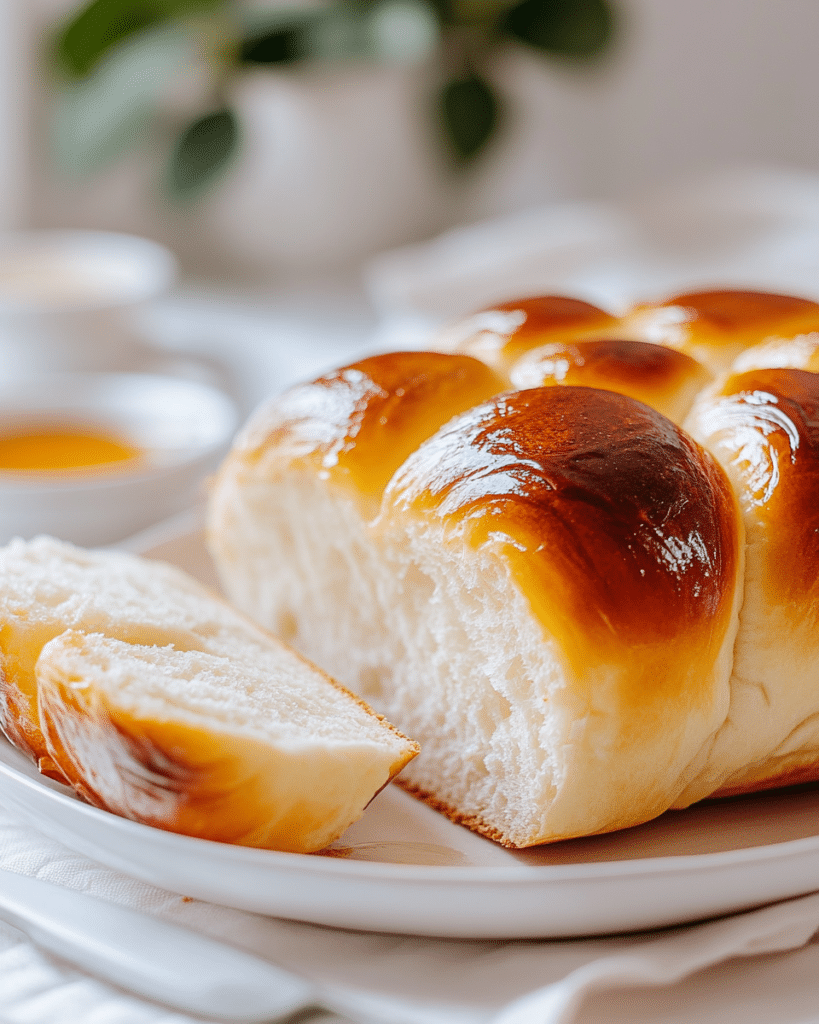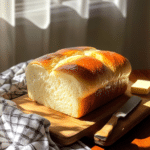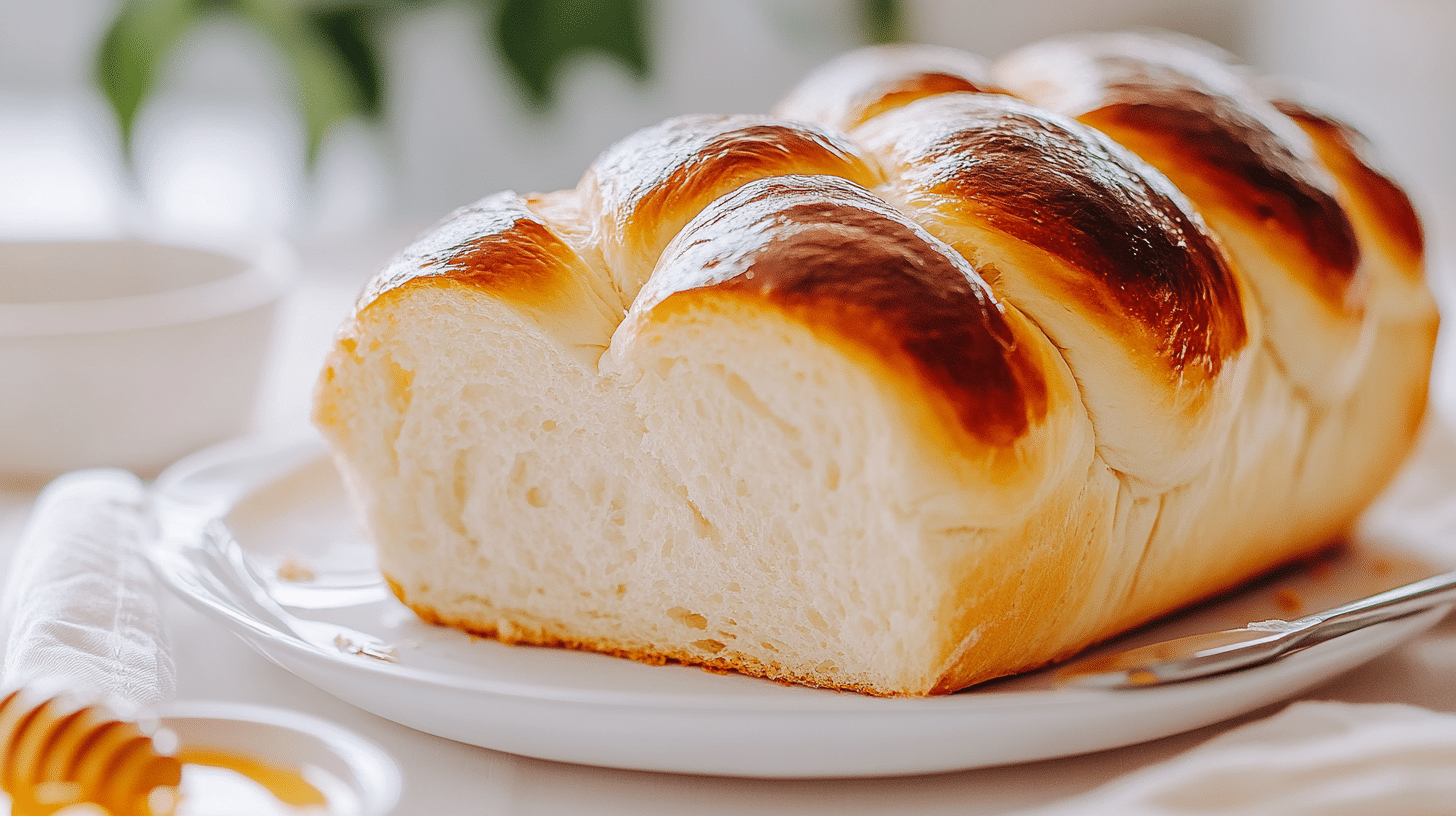This Easy Milk Bread Loaf is a dream come true for bread lovers! It’s a soft, fluffy, and incredibly tender bread with a subtly sweet flavor and a beautiful, golden crust. I love how this recipe is surprisingly easy to make, even for beginner bakers. It’s perfect for toast, sandwiches, French toast, or simply enjoying with a slather of butter. Get ready to experience the joy of homemade bread with this simple and rewarding recipe!
Why You’ll Love This Milk Bread Loaf
- Soft and Fluffy: This bread has an incredibly soft and fluffy texture, thanks to the milk and a special resting technique.
- Subtly Sweet: The touch of sugar enhances the flavor without making the bread overly sweet.
- Easy to Make: This recipe uses simple ingredients and straightforward instructions, even with a stand mixer.
- Versatile: Enjoy it for breakfast, lunch, or dinner, with sweet or savory toppings.
- Homemade Goodness: There’s nothing quite like the aroma and taste of freshly baked bread.

Ingredients for Easy Milk Bread Loaf
Here’s what you’ll need to make this delicious bread. The full list with measurements is in the recipe card below.
Main Ingredients
- Bread flour (Dry Ingredient)
- Sugar (Sweetener)
- Instant yeast (Leavening Agent)
- Cold water (Liquid)
- Cold milk (Dairy/Liquid)
- Sea salt (Seasoning)
- Unsalted butter (Fat)
Other Ingredients
- Butter
- Flour
(Note: the full ingredients list, including measurements, is provided in the recipe card below.)
Variations
I love this Milk Bread Loaf as is, but here are a few ideas for variations:
- Add Seeds: Stir in some sesame seeds, poppy seeds, or sunflower seeds to the dough for added texture and flavor.
- Cinnamon Swirl: Add a cinnamon-sugar swirl to the bread for a sweet and spicy twist.
- Cheese Bread: Add some shredded cheese, like cheddar or Parmesan, to the dough.
- Herb Bread: Stir in some chopped fresh herbs, like rosemary, thyme, or chives.
- Sweet Bread: Add some chocolate chips

How to Make Easy Milk Bread Loaf
Let me show you how to make this soft, fluffy, and delicious Easy Milk Bread Loaf:
Make the Bread Dough
- I mix the bread flour, sugar, yeast, water, and milk in a stand mixer, kneading on low speed until the dough is formed.
- I cover the mixing bowl and let it rest for 30 minutes. Meanwhile, I bring the butter out from the fridge, cut it into 4 pieces, and leave it on the counter to soften a little.
- I add the salt and continue to knead the dough for 1 minute.
- I add the butter cubes and knead until the dough passes the windowpane test. (This step takes me about 7 minutes, with 6 minutes on low speed and 1 minute on medium speed. The actual time it takes you depends on your mixer.)
First Rise
- I form the dough into a ball (it will be a bit sticky) and put it in a lightly greased bowl.
- I cover and let it rise in a warm place (between 82°F to 90°F / 28-32°C) for 1 hour, until it almost doubles in size.
Shape the Dough
- I transfer the dough onto a working surface and cut it (don’t pull it apart with your hand) into 3 even pieces.
- I form each piece into a ball.
- I cover the dough balls with a damp dish towel or greased plastic wrap, allowing them to rest for 15 minutes.
- I roll the dough out with a rolling pin to an oval shape and then roll it up to a log.
- I do the same for the other two pieces.
- I cover and let it rest.
- For each log, I rotate the dough 90 degrees before rolling them out again into long rectangles and rolling each rectangle back up into a cinnamon roll type of shape.
Second Rise
- I grease a 10 x 5 loaf pan and coat it with a thin layer of flour.
- I put the rolled-up dough into the pan.
- I cover with greased plastic wrap and let it rise in a warm place until it fills 80-90% of the pan (this takes about 1-1.5 hours).
Bake
- I preheat the oven to 375°F (190°C) in the last 20 minutes of proofing. I move the rack to about ⅓ of the way from the bottom.
- I put it in the oven to bake for 30-35 minutes. I loosely cover with a piece of foil after baking for 15 minutes to prevent the bread color from turning too dark.
- Remove from the oven
Cool and Serve
- I remove the bread from the oven and drop the pan on the counter top (from around two inches up) once to help prevent it from shrinking.
- Then, I transfer the bread to a cooling rack right away.
- I brush the top with melted butter and let it cool for 15 minutes before enjoying.

Tips and Tricks for the BEST Milk Bread
Here are my secrets for making this bread truly exceptional:
- Use Bread Flour: Bread flour has a higher protein content than all-purpose flour, which helps to create a chewier bread.
- Warm Water and Milk: Using warm liquids helps to activate the yeast.
- Don’t Over-Knead: Knead the dough just until it’s smooth and elastic. Over-kneading can make the bread tough.
- Proper Rise: Allow the dough to rise in a warm place until it’s doubled in size. This is essential for a light and airy texture.
- Windowpane Test: The “windowpane test” is a way to check if the dough has been kneaded enough. Take a small piece of dough and stretch it between your fingers. If you can stretch it thin enough to see light through it without it tearing, the dough is ready.
- Dutch Oven (Optional): For an even crustier loaf, you can bake the bread in a preheated Dutch oven.
How to Serve
This Easy Milk Bread Loaf is delicious served:
- Warm with Butter: A classic and simple way to enjoy fresh bread.
- Toast: Toast slices and top with your favorite spreads, like jam, honey, or peanut butter.
- Sandwiches: Use it to make sandwiches.
- French Toast: Perfect for making French toast.
Make Ahead and Storage
You can store the dough, after the first rise, in the refrigerator for up to 2 days. Baked bread can be stored at room temperature for up to 3 days or frozen for longer storage.
FAQs about Easy Milk Bread Loaf
- Can I use a different type of flour?
- Bread flour is recommended for the best texture, but you can use all-purpose flour.
- Can I make this without a stand mixer?
- Yes, you can knead the dough by hand.
- My dough isn’t rising. What should I do?
- Make sure your yeast is fresh and active. Also, make sure the water and milk are warm, but not too hot.
Enjoy this soft, fluffy, and incredibly delicious Easy Milk Bread Loaf! It’s a perfect way to enjoy homemade bread without all the fuss.
Print
Easy Milk Bread Loaf
- Prep Time: 30 minutes
- proofing and resting time: 3 hours 15 minutes
- Cook Time: 35 minutes
- Total Time: 4 hours 20 minutes
- Yield: 1 loaf 1x
- Category: Bread
- Cuisine: Asian-Inspired
Description
This Easy Milk Bread Loaf recipe yields a soft, fluffy, and slightly sweet bread with a tender crumb. It’s perfect for toast, sandwiches, or enjoying on its own. This recipe uses a simple shaping technique for a beautiful loaf.
Ingredients
- 500g (3 3/4 cups) bread flour, plus more for dusting (see notes)
- 40g (3 tablespoons) granulated sugar
- 1 1/2 teaspoons instant yeast
- 225g (a little bit less than 1 cup) cold water
- 115g (1/2 cup) cold milk (whole milk recommended)
- 9g (1 1/2 teaspoons) fine sea salt
- 25g (1 3/4 tablespoons) unsalted butter, softened
For Coating and Brushing:
- Unsalted butter, for greasing the pan and brushing the loaf
- All-purpose flour, for dusting the pan
Instructions
1. Make the Dough:
- Combine Dry Ingredients: In the bowl of a stand mixer fitted with the dough hook attachment (or a large mixing bowl if kneading by hand), combine the bread flour, sugar, and instant yeast. Whisk to combine.
- Add Wet Ingredients: Add the cold water and cold milk to the bowl.
- Mix and Knead (Initial): Knead on low speed with the dough hook (or by hand) until the ingredients come together to form a shaggy dough.
- Autolyse (Rest): Cover the mixing bowl with plastic wrap or a clean kitchen towel and let the dough rest for 30 minutes. This allows the flour to fully hydrate, resulting in a softer, more extensible dough.
- Soften Butter: While the dough is resting, cut the unsalted butter into 4 pieces and let it soften slightly at room temperature.
- Add Salt and Knead: After the 30-minute rest, add the salt to the dough. Knead on low speed for 1 minute.
- Add Butter: With the mixer running on low speed, add the softened butter, one piece at a time, allowing each piece to fully incorporate into the dough before adding the next.
- Knead (Final): Once all the butter is added, continue kneading the dough for 8-10 minutes (the recipe suggests 6 minutes on low speed and 1 minute on medium speed in a stand mixer), or until the dough passes the windowpane test (see notes). The dough should be smooth, elastic, and slightly sticky. It should stick to the bottom of the bowl but pull away from the sides.
2. First Rise (Bulk Fermentation):
- Shape Dough: Lightly grease a large bowl. With lightly buttered or oiled hands, remove the dough from the mixer bowl. Gently shape the dough into a ball by pulling the sides down and tucking them underneath.
- Rise: Place the dough ball, seam-side down, in the greased bowl. Cover the bowl tightly with plastic wrap or a clean kitchen towel. Let the dough rise in a warm place (ideally between 82°F and 90°F / 28°C and 32°C) for about 1 hour, or until it has almost doubled in size.
3. Shape the Loaf:
- Divide Dough: Transfer the risen dough to a lightly floured work surface. Do not punch down the dough. Gently press out any large air bubbles. Use a bench scraper or a sharp knife to divide the dough into three equal pieces.
- Shape into Balls: Gently shape each piece of dough into a ball.
- Rest: Cover the dough balls loosely with a damp kitchen towel or greased plastic wrap. Let them rest for 15 minutes. This relaxes the gluten and makes the dough easier to shape.
- First Roll and Shape: Working with one dough ball at a time, use a lightly floured rolling pin to roll the dough out into an oval shape. Then, starting at one end, tightly roll the oval up into a log.
- Rest. Cover and let it rest for another 15 minutes.
- Final Roll and Shape: Rotate each dough log 90 degrees. Roll each log out again into a long rectangle. Then, starting at one short end, tightly roll the rectangle up into a cinnamon roll shape.
4. Second Rise (Proofing):
- Prepare Loaf Pan: Grease a 10×5-inch loaf pan with butter. Lightly dust the greased pan with flour, tapping out any excess.
- Place in Pan: Place the three rolled-up dough pieces, seam-side down, side-by-side in the prepared loaf pan.
- Proof: Cover the loaf pan loosely with greased plastic wrap. Let the dough rise in a warm place until it fills 80-90% of the pan (this will take about 1-1.5 hours).
5. Bake the Bread:
- Preheat Oven: During the last 20 minutes of the proofing time, preheat your oven to 375°F (190°C). Position a rack in the lower third of the oven.
- Bake (Covered): Bake for 15 minutes.
- Bake (Uncovered): Loosely cover with a piece of foil, bake for another 15-20 minutes, until golden brown.
- Check for Doneness: The bread is done when it’s a deep golden brown and the internal temperature reaches 190-200°F (88-93°C).
- Cool: Remove the bread from the oven. Immediately after baking, drop the pan on the counter from a height of about 2 inches. This helps to prevent the bread from shrinking as it cools.
- Remove and cool: Transfer the bread to a wire rack immediately. Brush the top of the hot loaf with melted butter. Let the bread cool completely before slicing and serving.
Notes
- Bread Flour: Bread flour has a higher protein content than all-purpose flour, which results in a chewier bread with a better rise. You can use all-purpose flour, but the texture may be slightly different. The recipe author uses all-purpose.
- Instant Yeast: Instant yeast can be added directly to the dry ingredients. If using active dry yeast, you’ll need to proof it first: combine the yeast with the warm water and a pinch of the sugar and let it sit for 5-10 minutes, until foamy.
- Windowpane Test: The windowpane test is a way to check if the dough has been kneaded enough. To perform the test, take a small piece of dough and stretch it gently between your fingers. If the dough is properly kneaded, you should be able to stretch it thin enough to see light through it without the dough tearing.
- Rising Time: Rising times can vary depending on the temperature of your kitchen.
- Loaf Pan Size: A 10×5-inch loaf pan is recommended.
- Cooling: Cooling the bread completely before slicing is important for the best texture.
- Storage store at room temp.

